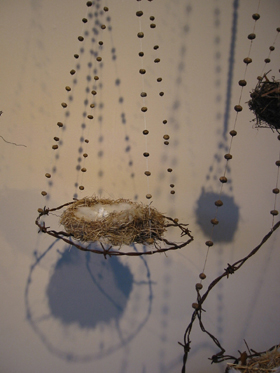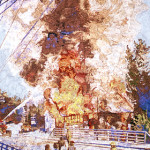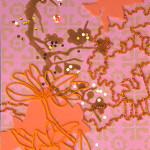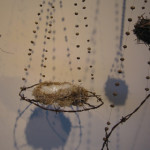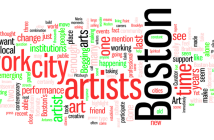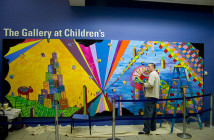Nature is everything (energy, matter, etc.) (as far as I know). impersonature is the 27th show at Sand T’s artSPACE@16. Nature, in our anthropocentric concept of reality, is most often defined by everything not in any way manipulated by man, or, perhaps, the opposite of the synthetic. In impersonature Sand T, artSpace@16’s founder, built a show around humanity’s interpretation of “the natural.” The artists in the show all represent the natural by way of “impersonating, mimicking, rendering, personifying, and embodying the character or part of Nature;” each of their pieces demonstrating some form of synthesized or replicated nature. In doing this, the artists all self-consciously frame their work, to varying degrees, with the binary opposition of Man/Nature both to some success and failure.
Dustin Tracey’s work is the archetypal of the show and, as large sculptures, its most dominant. At over seven feet tall, his work “Upright” (2005) bares a strong resemblance to a tree trunk that has been diametrically cut with the two halves misaligned to show the inner skeletal structure of the work. The inner anatomy of the ‘trunk’ is comprised of plywood as is the outer skin, but of thinner and lower quality wood that has been wet and split. It is this outer skin that gives “Upright” the look and feel (though ask first before touching) of a tree with its bark pealed away. It is his choice of materials and organic form that make his work seem natural but Tracey’s exposing of the trunk’s construction by revealing its inner structure that jars it from the viscerally natural experience one may get while approaching it. More than any other work in the show does he achieve a place somewhere in between natural and synthetic.
His “From the Same Cloth” (2004) work, part of his “Antepainting” (meaning "before painting") series, has a book like function and was constructed with similar methods as “Upright.” In order attach the front and back covers of the ‘book’ he uses forged steel that resembles sketchy clay models of cabinet hardware. Their jet-black appearance and what looks like an over-wrought attempt at giving the steel an organic shape, taint the work with too much of an unnatural aesthetic. The works in this series are interesting, however, as they are built from box-like rectangular frames, presenting and delimiting their naturalness into a very human form. Chandelier (no date supplied), a small stump pulled up from the ground with its roots attempts to “connect organic to synthetic” into one form, but it is this blatant attempt at blending the two sides that hurts the piece. It comes across heavy-handed compared to his others. Light bulbs sit amongst tangled roots or are drilled right into the wood, the wiring for the lights jumps out of the root system and appears like the wiring of Christmas tree lighting that we’d often try so hard to hide.
Marcella Anna Stasa has an “admiration…for the way in which nature adapts to humans.” She uses found objects taken from natural settings to create pieces that are actually quite synthetic. She arranges bones, dried animal feces, carcasses, bird-nests, various plant-life, and decomposed and/or rusted man-made objects to build patterns, mobiles, and dioramas. (I question the pervasive use of bird nests in her work as nesting birds so often reuse their nests perennially, if not taken by another bird.) Like Tracey some of her works sit somewhere in between natural and man-made, but she wants us to think of the eloquence of natural death and decay, and tries to find its beauty in her arrangements.
Kim Salerno uses a method that is oppositional to Stasa’s in that she uses materials that are “highly synthetic” to create forms which are very organic. Like Jamie Vasta, whose glitter paintings appear in the show, she is reconsidering the idealism of the landscape and long established concepts of Americana such as the Hudson River School to create layers of images that seem to represent the decay of modern culture. Salerno’s neon colored foam rubber, nylon string, bright beads, among other materials known for their plasticity, to make images that have a natural chaotic-ness to them, which is indeed at odds with the materials used to create them.
Jamie Vasta’s paintings are celebrations of our fear of and fascination with nature. She makes images of horror dressed up in the shimmery dazzle of glitter, rendered as neatly as a Thomas Cole. She is able to replicate the serenity and idealism of the Hudson River School paintings while still creating unsettling images by making her works out entirely of glitter. The effect is subversive and beautiful.
Leigh Hall’s installation, “Curly Cue/Grass,” occupies the most wall space in the show. She created an intricate image of grass, vines, and weeds with illustration software and projected it across 26 feet of gallery space where she traced it with black masking tape. The fineness of the execution, aided by computer, smoothes out the work and facilitates in replicating the same experience for the viewer that Hall has while taking in the splendor of actual plant life. She makes a close up image of the lines, folds, even tapering, and richly variegation of plant life across fertile soil, the details of which we’d never get to notice. She captures just enough of ‘the natural’ in the nature she’s recreating to hold onto to the curious quality which draws us towards it.
I applaud Sand T in opening an arts space in such a low traffic area, though that does not seem to be a problem for her as artSpace@16 has broad notoriety. A few high-ways, round-a-bouts, and a couple neighborhoods with streets named after trees took me there, and it was worth the drive. I just wish my neighborhood was a little closer to hers, and now my own neighborhood feels inadequate for lack of such a space.
- Jamie Vasta (glitter paintings)
- Kim Salerno (2D mixed media)
- Marcella Anna Stasa (installation and sculpture)
Links:
artSPACE@16
"impersonature" is on view Until July 16th at artSPACE@16, located at 16 Princeton Rd. in Malden, MA.
All images are courtesy of the artists and artSPACE@16.

